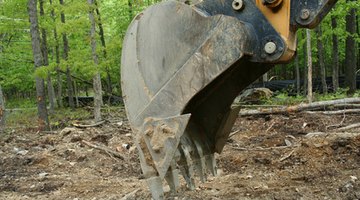How to Dig a Pond With a Backhoe
Adding a swimming, fish or waterfowl pond to your property can enhance your property value and add to the recreational use of your land. With a good pond design in hand you can dig a pond with a backhoe in a matter of days (depending on the size).

Key to getting the job done with a minimum of frustration involves making sure you plan on how and where you are going to dump the excavated dirt and having a good spotter to work with the backhoe operator. The spotter is a helper on the ground who checks the depth of the excavation and watches out for potential problems that can occur.
Things You Will Need
- Pond plans
- Tape measure
- Survey stakes
- Hammer
- Backhoe
- Dumptruck (or front loader)
- Orange spray paint
- Spotter
- Depth stick
Tip
Consider hiring a professional backhoe operator to dig your pond. While most people can learn the basics of operating a backhoe easily having a professional do the job will get it done faster.
Warning
Do not dig without checking with your local utilities company first to make sure there are no underground utilities that you could damage with a backhoe. Also, do not begin digging for a pond without the proper permits or you could face heavy fines from your local zoning board.
-
Use a tape measure and your pond plans to locate your pond on the land and drive survey stakes into the ground with a hammer to mark the edges. You want to use survey stakes that have an orange ribbon attached or whose tops are painted orange so your backhoe operator can see them clearly.
-
Scrape the top layer of the ground clean of grass, weeds or small shrubs using the tines of your backhoe bucket. Dump the debris into a dumptruck or front loader to be removed from the area.
-
Mark the ground with orange spray paint in sections. Divide the sections according to the depth of the pond shown on the plans in that area. Spray the excavation depth of the pond for each section on the ground as well so the operator and the spotter can read it easily.
-
Set the backhoe up in the center of the pond at one end of the pond. Have the backhoe operator dig in a straight line all the way across to the other end of the pond (dumping the dirt into your dumptruck or front loader for removal as the pond is dug). As the backhoe operator digs, the spotter should check the depth of each section with a depth stick (a long stick marked in 6-inch increments) to make sure it matches the plans before the backhoe is repositioned.
-
Bring the backhoe back to the end that it started digging on and set it the machine up so it can dig at a slight angle to its body. This way the machine is widening the trench begun in the center but adequately supported on firm ground. Repeat the process of digging, dumping and moving the machine until it reaches the opposite end of the pond area and then repeat this step. Do this until the entire pond is dug out on both sides of the initial center trench.
The Drip Cap
- Adding a swimming, fish or waterfowl pond to your property can enhance your property value and add to the recreational use of your land.
- As the backhoe operator digs, the spotter should check the depth of each section with a depth stick (a long stick marked in 6-inch increments) to make sure it matches the plans before the backhoe is repositioned.
- Do this until the entire pond is dug out on both sides of the initial center trench.
References
Resources
Writer Bio
Cassandra Tribe has worked in the construction field for over 17 years and has experience in a variety of mechanical, scientific, automotive and mathematical forms. She has been writing and editing for over 10 years. Her areas of interest include culture and society, automotive, computers, business, the Internet, science and structural engineering and implementation.
Photo Credits
- backhoe bucket image by Jim Mills from Fotolia.com
- backhoe bucket image by Jim Mills from Fotolia.com
More Articles



